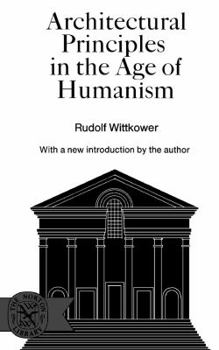Architectural Principles in the Age of Humanism
Select Format
Select Condition 
Book Overview
Seit Erscheinen der Erstauflage ist dieses Buch zu einem Klassiker geworden, der die Verbindung zwischen der Architektur und der Kultur der Renaissance beleuchtet. Wittkower hat definitive Erkl?rungen... This description may be from another edition of this product.
Format:Paperback
Language:English
ISBN:0393005992
ISBN13:9780393005998
Release Date:September 1971
Publisher:W. W. Norton & Company
Length:242 Pages
Weight:0.60 lbs.
Dimensions:0.6" x 5.0" x 7.9"
Customer Reviews
1 rating
More than just Architecture!
Published by Thriftbooks.com User , 20 years ago
Already recognized since 1949 as "a masterpiece in scholarship" in its field by several eminent architects, the 173 page tome: ARCHITECTURAL PRINCIPLES IN THE AGE OF HUMANISM, 4th ed. (1971) by Rudolf Wittkower; had, incidentally, also provided an in-depth explanation on proportion and ratio as they differed in usage between architectural procedure and Boethian mathematics. Of special importance is part four 'The Problem of Harmonic Proportion in Architecture' (p. 101) where the author made the salient point that "Although the Pythagoreo-Platonic concept of the numerical ratios of the musical scale never disappeared from mediaeval [sic], theological, philosophical, and aesthetic thought, there was no over-riding need to apply them to art and architecture" (p. 159).Rudolf Wittkower unknowingly provided in part four the distinction between an elite Quadrivium education containing Boethian "mathematical arts" while "the 'liberal arts' of painting, sculpture, and architecture were regarded as manual occupations" (p. 117). The author explained "That the high Renaissance architects shunned theory" and "that they were practitioners rather than thinkers" (p. 30). And further "Italian architects strove for an easily perceptible ratio between length, height, and depth" (p. 74). So then according to this author, all of the Renaissance architects conception of architecture was based on a "commensurability of ratios" (p. 108).Rudolf Wittkower indicated "that the [Renaissance] architect is by no means free to apply to a building a system of ratios of his own choosing, that the ratios have to comply with conceptions of a higher order and that a building should mirror the proportions of the human body" (p. 101). In developing the centrally planned church, Renaissance architects faced the dilemma of the pragmatics of church construction combined with the belief in divinity and the acceptance of Roman Catholic dogma. The Church was to provide the "easily perceptible ratio" with the simple logic that "As man is the image of God and the proportions of his body are produced by divine will, so the proportions in architecture have to embrace and express the cosmic order" (p. 101). That cosmic order and harmony are contained in certain numbers Plato explained in his TIMAEUS.Assigned to the architects, a Quadrivium trained Roman Catholic friar and musical theorist, Franchino Gaffurio (1451-1522) "in a truly Platonic spirit he regarded this principle of harmony as the basis of macrocosm and microcosm, body and soul, painting, architecture, and medicine" (p. 124). It was under this famous Renaissance musical theorist in 1525 that "the old belief in the mysterious efficacy of certain numbers and ratios was given new impetus" (p. 102). "It was Pythagoras who discovered that tones can be measured in space. What he found was that musical consonances were determined by the ratios of small whole numbers. If two strings are made to vibrate under the same conditions, one






